Red-footed tortoises remain a favorite tortoise.
What you are about to read is a history of ongoing events that began in late 1998 with three hatchling red-footed tortoises that grew to become females that went on to produce well over 200 hatchlings. Some of those hatchlings have gone on to produce, as well, resulting in F2, or second generation, redfoots. Over the years I’ve made changes to the norm when it comes to raising red-footed tortoises, based on my personal experiences and observations. This article will provide the details of my methods that currently result in flawless specimens.
Brief History of the Red-Footed Tortoise
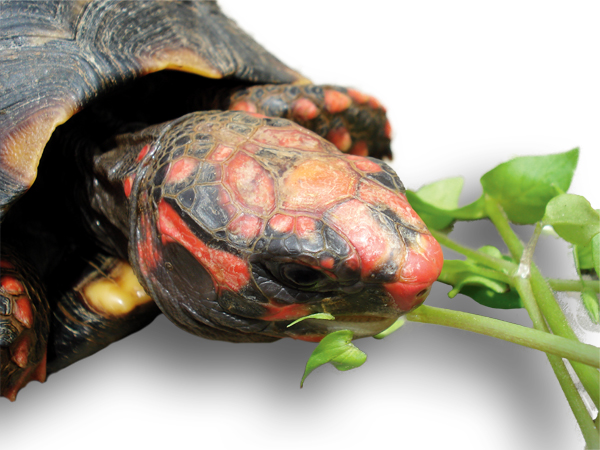
Terry Kilgore
A 3-year-old Brazilian redfoot. The exceptional red coloration on the heads of Brazilian redfoots led to them being given the name “cherryheads.”
The gregarious red-footed tortoise (Chelonoidis [formerly Geochelone]carbonaria) has been popular with tortoise keepers for decades, since specimens were first imported from a vast range in northern South America. A medium-sized tortoise that seldom grow larger than 15 inches in captivity, it is one of the most personable tortoises in captivity today.
Redfoots have been imported from farms in Venezuela and Brazil, and from the Guyana/Suriname area, where they are taken from the wild. To the best of my knowledge, wild-caught (WC) specimens now account for very few of the tortoises available today, in comparison to the 1970s thru 1990s, when they were imported by the thousands from Colombia, in particular, as well as Guyana/Suriname. Redfoots are still exported in relatively small numbers, but private breeders are now providing greater numbers of hatchlings.
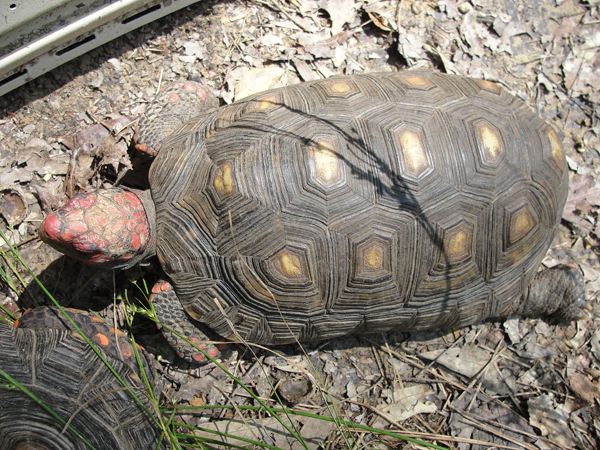
Terry Kilgore
Humidity is crucial when keeping a redfoot; however, the author does not recommend providing it by keeping a tortoise’s substrate wet, due to the risk of shell rot developing on the plastron.
Chelonoidis carbonaria has not as yet had any subspecies determination. Specimens from the northern part of its range exhibit subtle physical differences and some tendency to follow a unique color pattern, but coloration has proven to be the least reliable method of identifying the origin of individuals. Factoring in the number of tortoises that were imported from the entire northern range, over a number of decades, it has become inevitable that locale hybrids/integrates exist in today’s breeding programs, making it increasingly difficult to identify individual origins.
Hybridization has become a controversial subject, especially in regard to redfoots from the southern portion the tortoise’s range, in Brazil, etc. There, physical differences are virtually nonexistent, yet coloration can be quite variable. These tortoises obviously differ in appearance from their cousins further north.
So-called “cherryheads” were named by a group who imported tortoises that had been illegally trucked from Brazil to Paraguay (Brazil was closed for exportation at that time)—these tortoises displayed screaming red coloration on their head and legs. These importers figured that by calling these tortoises cherryheads they could sell them at a higher price—it was strategic marketing genius that worked! As a result, the name “cherryhead” has come to be used to describe all redfoots from Brazil, much to the detestation of many redfoot breeders today.
Four Key Parameters
The success of those who keep herps—chelonians in general and C. carbonaria in particular—is gauged by their ability to keep the animals healthy in an environment that meets their specific needs. To keep red-footed tortoises successfully, there are four parameters that must be kept in balance: temperature, humidity, lighting and diet.
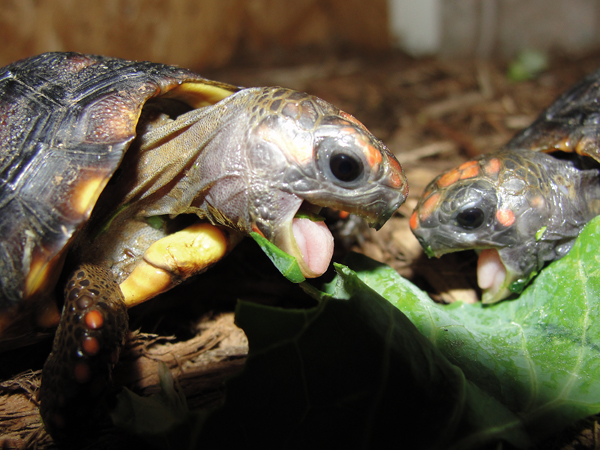
terry kilgore
Redfoots are omnivorous, meaning they include plant, fruit and animal protein in their diet.
- Temperature. A friend from Venezuela once told me temps in South America seldom vary much more than 20 to 25 degrees Fahrenheit year-round. “There are two seasons here,” she said, “wet and dry!” Redfoots don’t hibernate, either. Therefore, I do not provide a hot side and a cool side in my red-footed tortoise enclosures. Instead, I maintain an ambient temperature in the mid to upper 80s throughout the enclosures.
- Humidity. An ambient humidity level of 60 to 80 percent is optimal for red-footed tortoises. You may have to get creative if you live in a dry environment, using warm-air humidifiers or misters with timers, etc. I often spray hatchlings until they drip to keep their carapaces humid. Do not maintain humidity in a redfoot enclosure by making the substrate wet because these tortoises have a tendency to develop shell rot on their plastrons if kept under such conditions. Too often we see red-footed tortoises that resemble pineapples or hand grenades, exhibiting a condition known as “pyramiding” in which carapace scutes are elevated. This condition may result if redfoots are maintained in an environment that is too dry, which will also be apparent if the tortoises’ eyes are watering.
- Lighting. Unlike most other tortoises, redfoots do not have to bask in sunlight to maintain vitamin D3 in their system. The only lighting needed for an indoor redfoot habitat is a low-wattage UVB bulb over the tortoises’ food plate and shallow water dish, and even that is optional. A good 75 percent of my indoor redfoot habitats, for both hatchlings and adults, do not utilize supplemental lighting of any kind. I can’t count the number of times redfoot keepers have asked me, “Why won’t my redfoot come out of its hide?” only to find they have been keeping their redfoots under a high-wattage UVB bulb they thought the tortoises needed to bask under. Once I tell them to discard that lighting, they get back to me all excited, “I’ve seen my redfoot out exploring for the first time during the day!”
- Diet. Red-footed tortoises are omnivorous, meaning they eat fruit, plant and animal proteins, and they acquire necessary vitamin D3 from their diet. A good balance of greens, fruit and animal protein has proven best in my experience. I also offer wildflowers and various weeds, including dandelions, that grow in my backyard (if you do likewise, be sure these items have not been sprayed with any pesticides, fertilizers, etc.). In order of highest calcium content, I like to offer grape leaves, dandelion greens, endive, escarole, turnip greens, collards, hibiscus leaves and flowers. Avoid kale and spinach. Where I live, sometimes only a very limited choice of greens is available during the winter, so I’ll buy collards and feed my redfoots those for awhile. Variety is not necessarily important when it comes to greens so whatever is seasonal or on sale is fine. Unlike other tortoises, redfoots can be offered fruit regularly. I usually offer strawberries, peaches, pineapple and black plums—whatever is in season, but seldom banana and never tomato, which can result in diarrhea.
Breeding Groups
As mentioned at the beginning of this article, my redfoot breeding project began with three hatchlings I acquired in 1998 that later became my breeding females. They were obtained from a breeder who owned the male that sired them, and because this male had been on stud loan among a number of females, my three females could be siblings or related by sharing the same father.
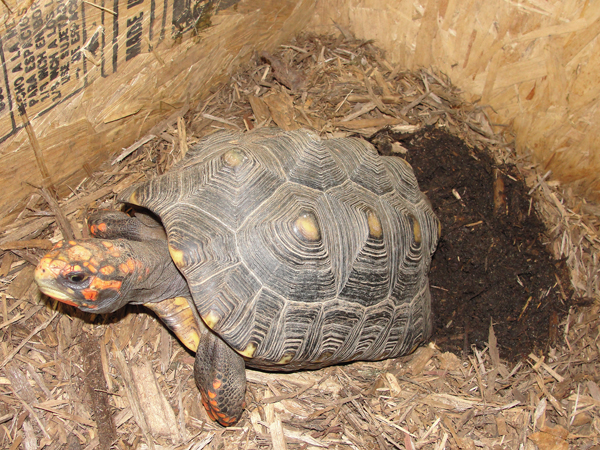
Terry kilgore
A female nesting inside one of the author’s indoor habitats.
I added an unrelated WC male to the group in August 2003. He was about 10 inches SCL (straight carapace length) at the time, and by then two of my females were approaching 10½ inches. No breeding activity was observed until May 2004, after which some uniquely colored babies resulted.
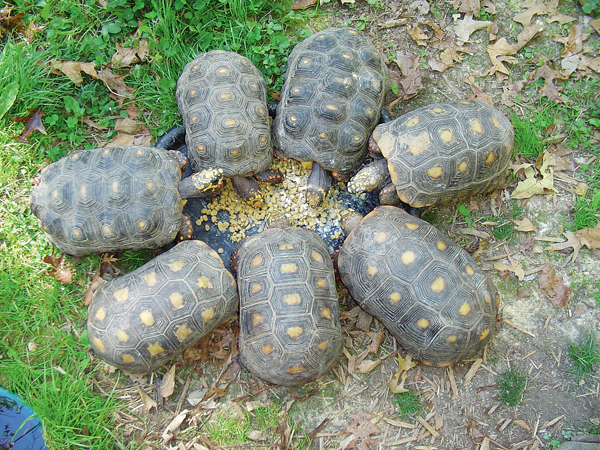
terry kilgore
This is the author’s original 2004 breeding group.
Having read that male red-footed tortoises were better breeders with competition from other males, I began looking for another male to enhance my group. I ended up getting a trio comprised of a 10½-inch-long male and two females (11½ and 12 inches) that were part of a group of WC Guyana imports that had reportedly been in captivity for five years. It was late July 2004, and I was looking forward to witnessing some male-to-male combat upon introducing them to my existing group after first having them examined by my veterinarian, having fecal tests done and putting them through quarantine.
Finally the day of introduction arrived, but these guys turned out to be lovers, not fighters. There was no male-to-male combat, no head-nodding, ramming or any of that! However, hardly a day went by from late May thru September 2004 that there was not breeding activity taking place.
The most pronounced breeding behavior was the loud clucking/quacking of the males. When the early-summer rains arrived, all seven tortoises could be seen cruising around their outdoor enclosure in the rain. Then the sun came out and it sounded like my backyard had been invaded by a flock of chickens and ducks! The synchronized clucking was music to my ears.
I also acquired an adult female Brazilian in 2004 and a mate for her in early 2005. This pair—the male typical cherry-red in coloration and the female yellow-orange—produced babies that were red to orange to black! The most unique characteristic of the Brazilians, though, is the “marbling” that often becomes most pronounced during the second year of growth.
Outdoor and Indoor Redfoot Habitats
The two breeding groups—the six “northerners” and the two Brazilians—were placed in a fenced-in, outside enclosure measuring about 500 square feet, which was growing with dandelions, red clover and various flowering weeds. It was divided into two habitats, one for each breeding group.
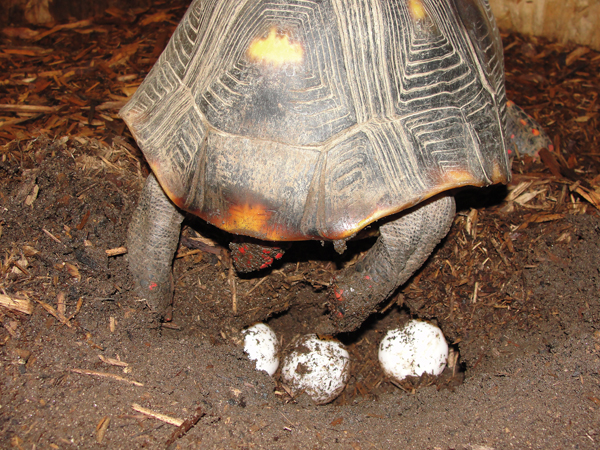
terry kilgore
Female redfoots will use their hind feet to reposition their eggs as they’re laying them.
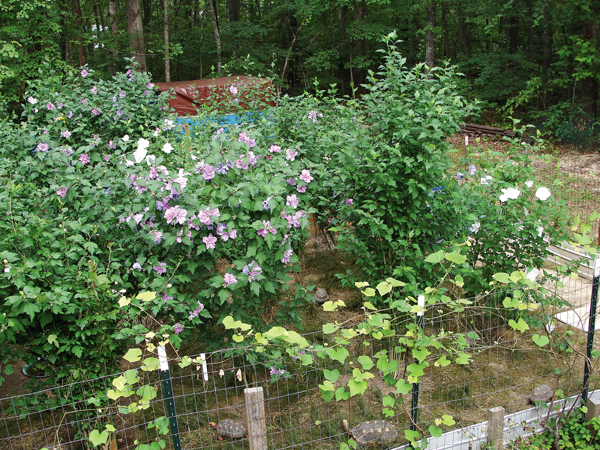
terry kilgore
The author’s 500-square-foot outdoor redfoot enclosure, planted with a variety of flowering weeds and clover. Note the redfoots along the bottom.
Walls around the enclosure were created using vinyl siding to prevent the tortoises from being able to see out, which can cause undue stress. Two water heater drain pans measuring about 25 inches in diameter by 3 inches deep were sunk into the ground to be used as water dishes. A hide made of OSB (oriented strand board, available at building supply stores) measuring 15 inches tall and with a hinged lid, containing about 6 inches of cypress mulch for a substrate, was included in each of the two habitats.
Each group was observed grazing on a very casual basis, and every third day or so additional greens and fruits were offered. Animal protein in the form of rehydrated dry cat food sprinkled with NOW calcium carbonate powder (no D3 added) was offered on large plastic serving plates once a week to aid the calcium needs of the egg-producing females. And produce eggs they did!
The indoor habitat is a “bunk-bed” arrangement utilizing two enclosures, both measuring about 14 feet long and 28 inches deep, with hinged front walls for easy access. The substrate is a 4-inch-deep layer of cypress mulch. Males are kept in the top enclosure and females are maintained below, with a nest box available.
Nesting and Egg Deposition
Early on, females started nesting in late July and as late as mid-March on a roughly 30-day cycle. Currently, they sometimes don’t start until November, the Brazilians especially.
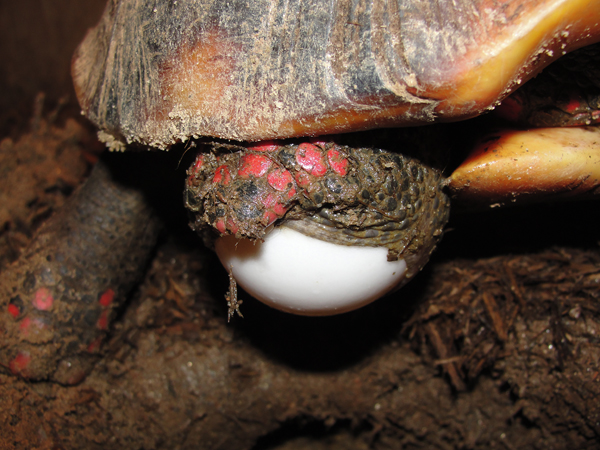
terry kilgore
When red-footed tortoise eggs are first laid, they are snow-white.
I could tell nesting was on their mind by their prancing around the outside enclosure and sniffing at the ground. Occasionally test digs were made, but that was very seldom. Once a nesting spot was decided upon, the females would urinate on the ground to soften the area to allow for easier digging. Nesting was usually late in the day and would sometimes take two hours or longer to complete.
Red-footed tortoises dig huge nesting holes. A foothold on either side is established; they’ll place one foot on one while they scoop out the dirt with the other foot. Then they’ll switch feet, scooping with the other one. The nest is often large enough for a substantial portion of the rear of a female’s shell to drop into. She will dig beneath herself as far as her rear feet will reach, so when she begins to lay her eggs she can push the eggs forward to allow room for others.
Once the hole is complete, the female redfoot will begin dropping the eggs, repositioning them as they are laid. During the egg-laying, she will be in a “trance,” staring straight ahead. I often raise females up by the rear of the carapace with one hand to withdraw eggs from the nest, and once an egg was dropped into my hand by a female that was apparently totally oblivious to what was going on. Then she dropped another!
Female red-footed tortoises kept indoors during the winter will start scratching around in the cypress mulch substrate when they’re ready to dig a nest. I will usually place a female exhibiting this behavior into the nest box that is attached to the indoor habitat. I have found that bagged cow manure mixed with top soil works best in the nest box. I soak the nesting medium with very hot water and wait for it to recede before placing the tortoise inside, where the heat and dampness seems to inspire females to nest.
Early in the season, I place a barrier at the entrance to an occupied nest box to keep other females out. On one occasion in early February 2006, while making a routine check, I found I had two females nesting at the same time; in an area that measured only 3 feet square. That was a long night, photographing and preparing the eggs for the incubators. Fifteen eggs went into the incubators that night!
Once all the eggs are deposited, a female will reverse the process and start scooping the excavated dirt back into the hole, covering the eggs. She will rotate, shifting from side to side, packing the soil as she goes. Once done it is not real obvious where the nest is.
Once the female is done laying, the eggs are removed for incubation. Prior to being placed in the incubator, each egg is carefully marked using a fine lead pencil with a code indicating the female who laid the egg and the date it was laid.
Incubation
This is where it gets fun—waiting 115 to 150 days for the eggs to hatch, with 125 days being the average. Incubating tortoise eggs gives new meaning to the word “patience.”
When red-footed tortoise eggs are first laid, they are snow-white. The next day they take on a vague pink color, and seven to 10 days after that, a white spot will appear, indicating fertility. As the days go by, this spot grows until the egg is totally white again. Unlike turtle eggs that are translucent, redfoot eggs are opaque and not easily candled. You can’t see what’s going on in them.
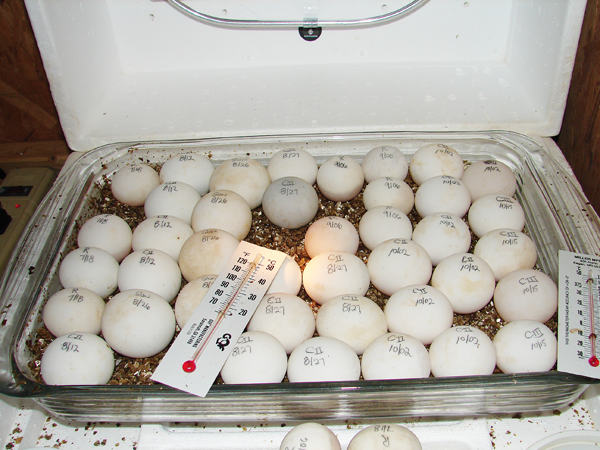
terry kilgore
The average incubation duration for redfoot eggs is 125 days. Patience is definitely required!
I have always used coarse vermiculite as an incubation medium. Put it in a bowl, add hot water, mix it up and squeeze the water out. That’s about all you have to do to prepare it. Each clutch is placed into a small, lidless plastic egg container containing about an inch of moist vermiculite. Each egg is gently pushed into the medium about one-third deep. The plastic container is then placed into an incubator with the thermostat set at 84 to 85 degrees. Two small plastic cups of water are also kept in the incubator for added humidity.
Every other day I open the lid of the egg container for a minute to allow fresh air in. As needed, I fill the cups with hot water, which adds a little humidity.
The only differences I have found among the different locales are the size and number of eggs that are produced. The three Colombian bloodline females averaged six to eight eggs, which were seldom larger than 15/8 inches. The two Guyana females, which were at least 1 to 1½ inches larger SCL and possibly 10 years older, laid eggs measuring 1¾ to 2 inches in length and averaged four to five per clutch (seldom six).
Because all the females were bred with the same Guyana males, I’m inclined to believe the Colombians lay smaller eggs traditionally.
Hatching
Suddenly, on the shell of a pure-white egg will appear a tiny break, known as a “pip”—the baby tortoise inside has poked this tiny hole in the shell and taken its first breath of air.
This is done using a small projection on the tip of the hatchling’s upper jaw, right below the nostrils, called an egg tooth. The tiny creature will then slowly spin inside the egg while poking similar holes in a circle all the way around the egg. Then, as if a can opener had been used, the top of the egg is cut off.
After I see a couple of good pips I’ll move the egg to a nursery incubator, where the baby tortoise will finish hatching and absorbing its yolk sac. During this time the egg is placed into an even smaller plastic container lined with paper towel that has been saturated with water. The pipped egg is placed on top of this, and another saturated and folded paper towel is placed over the top of the container to create a lid.
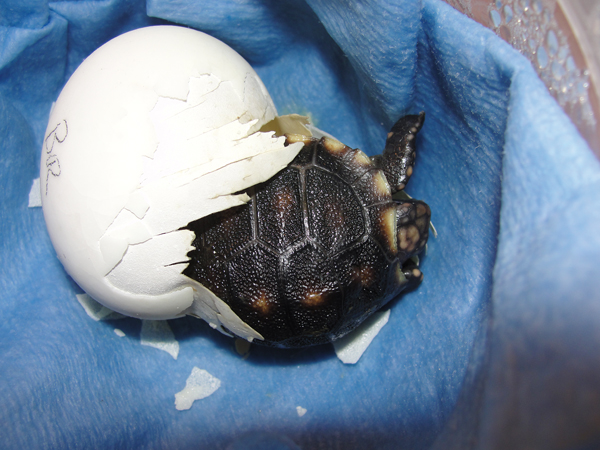
terry kilgore
A newly emerged hatchling black Brazilian redfoot.
It may take two days for any changes to occur, and then, as if the hatchling inside the egg suddenly woke up, it will begin pushing against the shell from inside, and then—pop!—out comes a leg or two as the tiny tortoise works its way out of the shell. Hatchlings sometimes emerge from the shell tail first, unless there is a considerable amount of yolk sac that is yet to be absorbed. Once a hatchling is out of its shell, clean, moistened paper toweling replaces the old toweling in the container. The yolk sac will be absorbed within three to four days.
Hatchling Care
Hatchling redfoots are raised in simple plastic containers that are raised slightly at one end to allow shallow water to stand in the opposite end. All hatchlings are misted two to three times a day with warm water using a hand-held plant mister, almost from Day One. Long-fibered sphagnum moss, pulled apart to become “fluffy” and lightly misted, is provided for the hatchlings to hide in. It can take up to about four days before they will take their first bite of endive or strawberry, etc. Once they realize that eating is a good thing, they don’t stop!
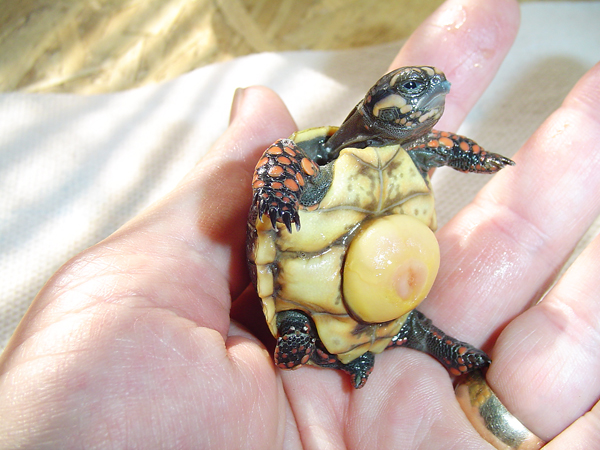
terry kilgore
This newly hatched redfoot still has its egg yolk attached.
It is important to note that many tortoise breeders have come to the conclusion that a humid hide is vital in preventing the abnormal carapace scute development commonly known as pyramiding. Many of us have young adults that display this condition, and although there doesn’t seem to be any adverse effects, other than the unusual appearance, only time will tell what the long-term outcome and effects will be.
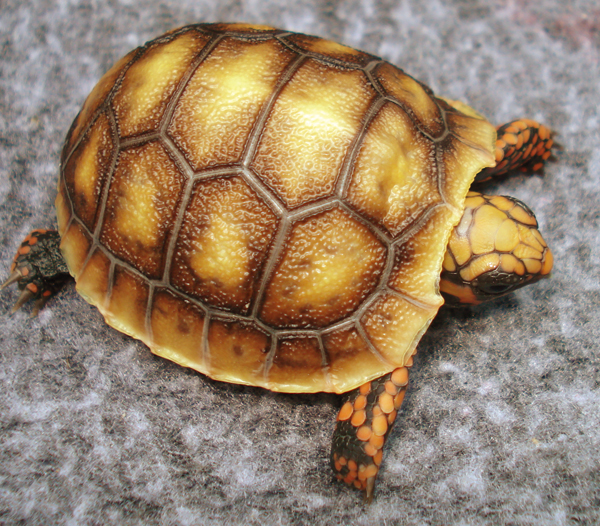
terry kilgore
An unsually colored hatchling.
I feed hatchlings the same diet as my adults, though have chosen to not supplement—no extra calcium or protein added to their diet—until they are 6 months old and about 3 inches long. Calcium-rich greens such as dandelion, endive and escarole have been their staple, with strawberry, peaches, plums and pineapple offered twice a week. At 6 months I begin lightly sprinkling the previously mentioned calcium carbonate powder on their greens. A rehydrated dry cat food, with a high percentage of animal protein (46 percent) and low fat (10 percent)—is offered as a meal once a week to meet protein needs (and it is relished!).
My methods for keeping and breeding red-footed tortoises are not etched in stone, though they have worked very well for me over the years. It is always recommended that keepers add their own ideas to the information available today, in the hope of making this hobby easier and more rewarding for all who follow.
Terry Kilgore has been chasing turtles and tortoises most his life. He acquired his first turtles as a child in 1952, and got serious about them around 1976. His knowledge comes exclusively from his own hands-on experiences, along with getting to know a few not-well-known (by choice) old-time veteran breeders. For further information and more examples of his redfoot raising and breeding experiences, visit turtletary.com.


